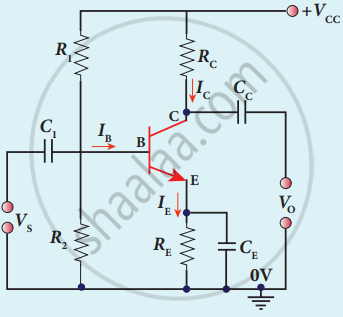Advertisements
Advertisements
प्रश्न
Describe the function of a transistor as an amplifier with the neat circuit diagram. Sketch the input and output wave forms.
उत्तर
i. Amplification is the process of increasing the signal strength (increase in the amplitude)
ii. NPN transistor is connected in CE configuration
iii. To start with, the Q point is fixed to get a maximum signal swing at the output.
iv. RC – to measure the output voltage
C1 allows only AC signals to pass,
Bypass capacitor CE provides a low resistance path
Coupling capacitor CC is used to couples the next stage amplifier.
Vs input source signal
IC = BIB `(∴ "B" = "I"_"C"/"I"_"B")`
VCE = VCC – ICRC

Transistor as an amplifier

Input and output waveforms showing 180° phase reversal.
Working of the amplifier:
a. Working of the amplifier:
- Input signal Vs increases the forward voltage across the emitter-base. IB increases. also increases IC also increases β times.
- This increases the voltage drop across Rc which decreases VCE.
- Therefore input signal in the positive direction produces an amplified signal in the negative direction at the output. Hence output signal is reversed by 180°.
b. During negative half cycle:
- Input signal Vs decreases the forwarded voltage across the emitter-base. As a result, IB decreases IC increases.
- Increase in IC decreases potential drop across Rc and increases VCE.
- Input signal in negative direction produces an amplified signal in the positive direction at the output.
- Therefore 180° phase reversal is observed during the negative half signal.
APPEARS IN
संबंधित प्रश्न
In a BJT, the largest current flow occurs ______.
Least doped region in a transistor ____________.
In a common emitter amplifier circuit using an n-p-n transistor, the phase difference between the input and the output voltages will be: ____________.
In an npn transistor circuit, the collector current is 10 mA. If 90% of the electrons emitted reach the collector, the emitter current (IE) and base current (IB) are given by ____________.
In a transistor, a change of 8.0 mA in the emitter current produces a change of 7.8 mA in the collector current. Then change in the base current is ____________.
A transistor when connected in common emitter mode has a ____________.
A pnp transistor is used in common-emitter mode. If a change of 40 µA in base current brings a change of 2 µA in collector current with 0.04 V in base-emitter voltage, then the input resistance is ____________.
In a transistor, doping level in base is increased slightly, the collector current and base current respectively ______.
In common emitter mode of transistor, the d.c. current gain is 20, the emitter current is 7 mA. The collector current is ______.
For an ideal diode, the current in the following arrangement is ______.

